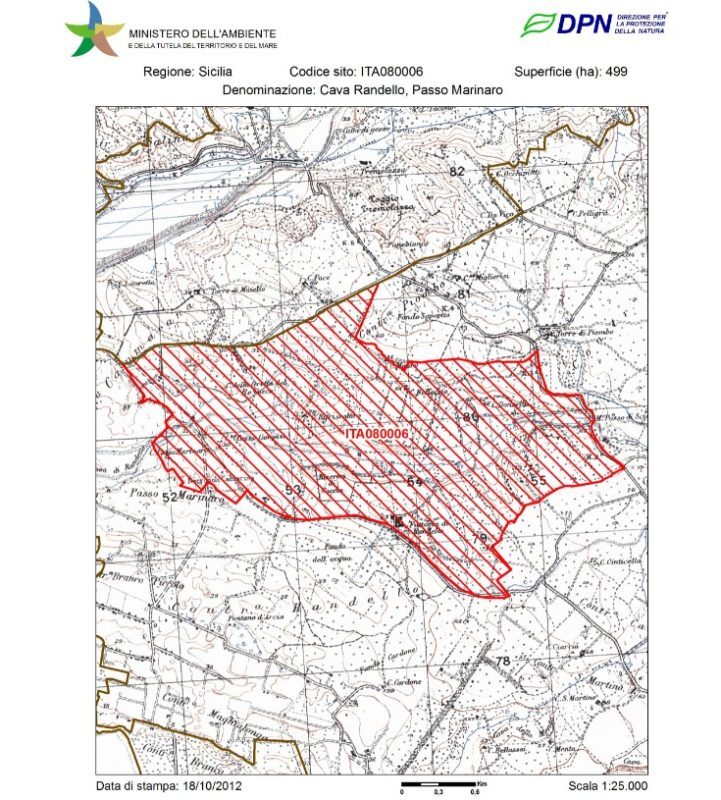Cava Randello, Passo Marinaro
Site type: SAC - Special Conservation Area
Code: ITA080006 - Hectares: 499
Description:
The site falls within the territory of the municipality of Ragusa. The soils are brown often mixed with Mediterranean red soils, more or less impoverished by washout. On the left bank of the Rifriscolaro there are often sand accumulations from transport along the slopes. In the valley floor there are heavy soils that tend to become silty soils. Rendizinici soils are present on narrow stretches of the right bank. The substrates are silts, sands, calcarenites, clays. The climate of the site is dry thermo-Mediterranean according to the terminology of Rivas Martinez. The natural part of the area is made up of several habitats. A) The habitat of the marl sloping down towards the valley floor. These are very arid soils, largely aphthic ones in which pre-desert thermo-Mediterranean formations settle dominated by Hedysarum glomeratum, Catapodium marinum, etc. dotted with rare specimens of Rhus pentaphylla (5330) .b) The habitat of red sands bearing arborescent formations with Juniperus turbinata Guss (5210) .c) The habitat of red sands mixed with limestone rocks, rich in Quercus ilex, oriented to reconstitution of the holm oak wood. In this habitat, rare specimens of Quercus calliprinos are found (9340) .d) The habitat of the humid and acidified slopes dominated by formations of Rhamnus alaternus and Teucrium fruticans rich in Cistus sp. pl.e) Formations of the sands afferent to the Malcolmietalia mainly given by Vulpio-Leopoldietum gussonei. f) Formations of the valley floor afferent to the Populietalia albae
Site of considerable geobotanical interest with vegetation aspects that have almost disappeared elsewhere: scrub aspects with Teucrium fruticans (Cava Randello),
very rare examples of groves with Quercus calliprinos (Marinaro Pass), presence of endemic species such as Leopoldia gussonei. The site turns out
also interesting from the faunal point of view for the presence of numerous species of Vertebrates, which for a rich and articulated invertebrate fauna that includes
endemic species or with a restricted range and rare and very localized species in Sicily.
hunting of the site (hunting reserve of a family of the Ragusa nobility) great is the naturalistic importance it possessed. The clearing of the forest
closed to Quercus ilex and its replacement with open Mediterranean scrub has increased the biodiversity of the biotope over time. Today it does
in fact, it is very rich in ecological niches hosting a large quantity of rare and endemic species. Another reason for the importance of the site is given by the
fact that it hosts the largest Sicilian population of Juniperus turbinata, which evidently finds here the suitable soils to reach its full
expressiveness. The third and most important reason for enhancing the site is the presence on the sands of formations of the Malcolmietalia bearing Muscari gussonei, especially
priority according to the Habitat Directive 43/92. The tunnel formations in Salix alba are degraded with traces without wood species.

Source: Ministry of the Environment Natura 2000 form
Ministerial data: Ministerial Map Natura 2000 form
Card insertion: Ignazio Caloggero
Photo: web
Information contributions: Ignazio Caloggero, Region of Sicily
Note: The populating of the files of the Heritage database proceeds in incremental phases: cataloging, georeferencing, insertion of information and images. The cultural property in question has been cataloged, georeferenced and the first information entered. In order to enrich the information content, further contributions are welcome, if you wish you can contribute through our area "Your Contributions"



